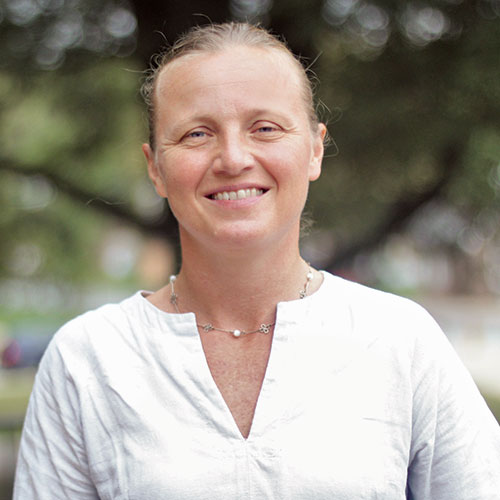Birthe Kjellerup

Birthe Kjellerup, the Pedro E. Wasmer Professor in Engineering at the University of Maryland’s A. James Clark School of Engineering, is testing a promising new approach to detecting and tracking COVID-19 outbreaks.
What is the problem or need that your research addresses?
The problem is that it’s already too late when patients test positive for COVID-19. There’s a 3–5-day incubation period during which patients don’t know they’re sick; patients might experience delays in getting tested; then they have to wait potentially days for their results. That’s about a week during which a person carrying the virus could potentially spread it to others.
We need a way to detect COVID-19 outbreaks earlier so that we can institute measures that prevent or slow the spread of the virus earlier.
Could you describe your research?
Clinical studies have shown that COVID-positive patients—including asymptomatic patients—shed the virus in their stool and fecal matter; so it follows that the virus must be identifiable in wastewater, too. Because the virus is detectable in stool and wastewater days before humans show symptoms, wastewater surveillance for COVID could give us a 5–7-day lead on identifying outbreaks (and on putting into place interventions that would help limit the spread of the virus). Otherwise, we would have to wait for people to develop symptoms, get tested, and receive their results.
We’re mapping where in wastewater basins the COVID-positive communities are, and layering that analysis with physical distancing data from the new Society and Economy Reopening Assessment (SERA) tool, developed by a multidisciplinary team of researchers led by the Clark School’s Maryland Transportation Institute. This will help us understand the mobility patterns of COVID-positive communities—how far are they traveling, and how frequently?—which could help us identify additional communities that may have also been impacted.
My collaborators in this work are Postdoctoral Researcher Devrim Kaya and Clark Distinguished Chair Deb Niemeier.
Why is this research needed?
Data is showing COVID hot spots within counties, rather than a generalized outbreak across Maryland. This work gives us a much more granular understanding of COVID cases and where they are, so that we can deploy helpful interventions designed specifically for that hot spot. For example, perhaps decision makers would recommend hot spot communities stay home and/or get tested, rather than deploying statewide restrictions.
In addition, this work also detects the virus when patients might otherwise be asymptomatic. These patients are less likely to be tested and may be more likely to unknowingly spread the virus to others. However, we can still detect COVID in wastewater, which clues us into a possible outbreak we might not otherwise know about until others are symptomatically ill.
How is this an engineering solution to the COVID-19 pandemic?
The foundation of environmental engineering is wastewater treatment. Wastewater and sewer systems are enormous and important parts of infrastructure to which almost every household in the United States is connected. And all of these systems are engineered. It takes an incredible amount of engineering knowledge to not only design and build these systems, but also to manage these systems through their life cycles.
The genesis of this work started with Bill Brower, one of my collaborators who used to work for DC Water; he suggested that I look into wastewater surveillance for COVID because of the promise of early detection. Thanks to the support of Chuck Schwartz, the chair of the Department of Civil and Environmental Engineering, funding was made available to kick start this research—now, we’re collaborating with other researchers and administrators across campus to help prepare for the Fall 2020 semester, and with decision makers from across the state to help prepare for county and local reopenings.
What does the future of this research look like?
COVID is hitting certain demographics harder due to already existing health disparities. And we know that engineering decisions can play a role in exacerbating or mitigating those disparities—for example, by licensing a power plant near one community and not another. A next step is to add another layer of data from the U.S. Census to better understand how the spread of COVID-19 is impacted by factors such as race, income, access to schools and healthcare, and proximity to environmental or health hazards such as Superfund sites.
Top